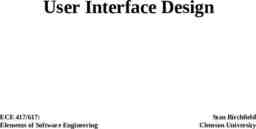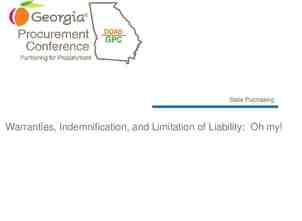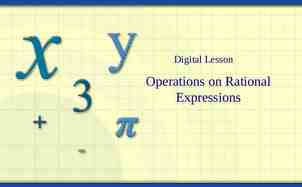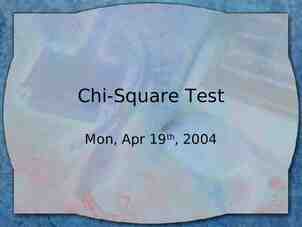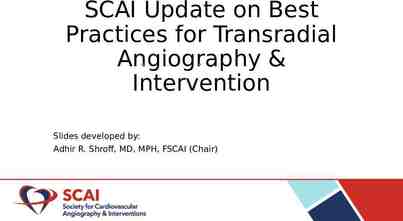November 2000 doc.: IEEE 802.11-00/349r1 Models for MPEG2 and Video
12 Slides66.50 KB

November 2000 doc.: IEEE 802.11-00/349r1 Models for MPEG2 and Video Conferencing Sachin Deshpande Srinivas Kandala Sharp Laboratories of America, Inc. Camas, WA 98607 Submissio n Slide 1 S. Deshpande, S. Kandala, Sharp

November 2000 doc.: IEEE 802.11-00/349r1 MPEG 2 VBR Source Model Scene 1 Scene 2 Scene Length N*d frames GOP 1 I GOP 2 GOP d GOP Group of Pictures Frame rate 30 frames/sec d is geometrically distributed I frames are log-normally distributed i.i.d or AR process B & P frames are iid log-normal B B P B B P B B P B B P B B I N Frames (typically N 15 or 12) Submissio n Slide 2 S. Deshpande, S. Kandala, Sharp

November 2000 doc.: IEEE 802.11-00/349r1 MPEG 2 Parameters 302 Per Second d GOPs – d is distributed geometrically GOP size Fixed I Frames Log Normal iid AR process P Frames iid – Log Normal B Frames iid – Log Normal Frame Rate Scene Size SDTV Rate HDTV Rate1 p 0.1 p 0.1 12 or 15 800 Kbits; 240 Kbits 12 or 15 3.2Mbits; 960 Kbits 240 Kbits; 160 Kbits 80 Kbits; 24 Kbits 960 Kbits; 640 Kbits 320Kbits; 96 Kbits and are the mean and variance of the lognormal distribution. 1 2 Submissio n HDTV may use layered video coding. The model here is only for base layer. Though not very popular, frame rates of 24, 50 and 60 are also supported. Slide 3 S. Deshpande, S. Kandala, Sharp

November 2000 doc.: IEEE 802.11-00/349r1 Video Conferencing Parameters Video-conferencing typically use H.263 or H.261 standards for video coding. CBR is usually employed, by the application using a rate control algorithms. In certain situations frames may be dropped to meet the target bit-rate. Typically no B frames are used due to low latency requirement. Packet size - typically can be 576 bytes/ 1000 bytes/ 1500 bytes for Internet. -Usage of smaller packet size (576 bytes) is more conservative since there is a less chance of getting fragmented. -Latency is not an issue for high rates even if we use 1500 bytes. Type Frame Rate Data Rate of the video stream 34 Kbps (CBR) Low Rate (used in 5-15 Frames/sec Dial-in modems) Medium Rate(ISDN) 10-20 Frames/sec 100 Kbps (CBR) 1.4 Mbps (CBR) High Rate (T1) 30 Frames/sec Submissio n Slide 4 Data Rate of the Audio stream 5.3/6.3 Kbps (CBR) 5.3/6.3 Kbps (CBR) 5.3/6.3 Kbps (CBR) S. Deshpande, S. Kandala, Sharp

November 2000 doc.: IEEE 802.11-00/349r1 Appendix: A Brief tutorial on Video Conferencing Standards Submissio n Slide 5 S. Deshpande, S. Kandala, Sharp

November 2000 doc.: IEEE 802.11-00/349r1 Introduction H.320,321,322,323,324 – Umbrella standards for multimedia communications (video conferencing) H.323: multimedia communication over packet switched networks that do not provide a guaranteed QoS – H.261, H.263( ) : video coding standards used with H.323 – G.711, G.722, G.723, G.728, G.729 : audio coding standards used with H.323 Submissio n Slide 6 S. Deshpande, S. Kandala, Sharp

November 2000 doc.: IEEE 802.11-00/349r1 Video Conferencing Modes Point-to-point / Multi-point conference Multipoint conference: – Centralized Multipoint control unit (MCU) – Distributed multipoint Unicast / Multicast Submissio n Slide 7 S. Deshpande, S. Kandala, Sharp

November 2000 doc.: IEEE 802.11-00/349r1 Video Coding for Video Conferencing Interactive nature: – Stringent requirements on latency (150-400 ms) – No B frames QCIF (176x144), CIF (352x288) typical frame resolutions (also possible : SQCIF, 4CIF, 16CIF) Frame rates : 5 to 30 frames per second Submissio n Slide 8 S. Deshpande, S. Kandala, Sharp

November 2000 doc.: IEEE 802.11-00/349r1 Video Coding for Video Conferencing Bit-rates (including audio): mostly CBR geared towards different client speeds – 56 Kbps (modem) (typically use H.263 at 515 fps, G.723 at 5.3/6.3 Kbps) – 128 Kbps (ISDN) (typically use H.263 at 1020 fps, G.723 at 5.3/6.3 Kbps) – (256 Kbps-1.5 Mbps) Higher bitrate (DSL, cable modem, T1) Submissio n Slide 9 S. Deshpande, S. Kandala, Sharp

November 2000 doc.: IEEE 802.11-00/349r1 Video Coding for Video Conferencing Packet sizes : – RTP payload for H.261, H.263, H.263 – Group of blocks (GOB) based packetization – Typically for Internet environment packet size can vary from 200-1500 bytes – Overhead of 40 bytes header (RTP UDP IP) per packet, so keeping packet size close to maximum transfer unit (MTU) of network desirable (taking into account latency requirement) Submissio n Slide 10 S. Deshpande, S. Kandala, Sharp

November 2000 doc.: IEEE 802.11-00/349r1 H.261, H.263 ( ) H.261 : – P x 64 Kbps (P 1,2,3.30) – Older standard, H.263( ) outperforms it H.263( ) : – H.263 : baseline standard, 4 optional annexes – H.263 : baseline standard, 16 optional annexes Submissio n Slide 11 S. Deshpande, S. Kandala, Sharp

November 2000 doc.: IEEE 802.11-00/349r1 Sample References for Video Conference Traffic Models Heyman D., Tabatabai A., Lakshman T.V., “Statistical analysis and simulation study of video teleconference traffic in ATM networks,” IEEE J Sel. Areas in Comm, 2(1), pp. 49-59, 1992. Yegenoglu F., Jabbari B., Zhang Y.Q., “Motion-classified autoregressive modeling of variable bit-rate video,” IEEE Trans. CSVT, 3(1), pp. 42-53, 1993. Reibman A., Berger A.W., “Traffic descriptors for VBR video teleconferencing,” IEEE/ACM Trans. Networking, 3, pp 329-339, 1995. Submissio n Slide 12 S. Deshpande, S. Kandala, Sharp

